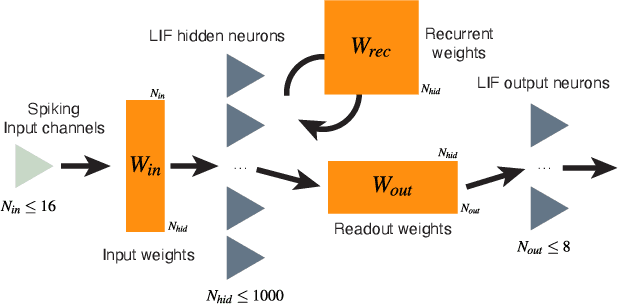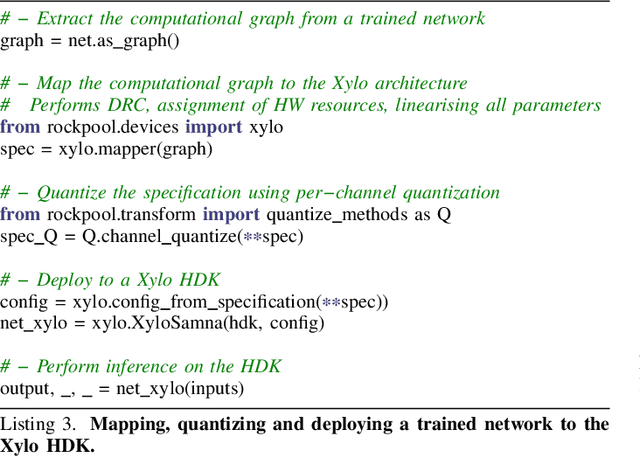Dylan Muir
Neurobench: DCASE 2020 Acoustic Scene Classification benchmark on XyloAudio 2
Oct 31, 2024Abstract:XyloAudio is a line of ultra-low-power audio inference chips, designed for in- and near-microphone analysis of audio in real-time energy-constrained scenarios. Xylo is designed around a highly efficient integer-logic processor which simulates parameter- and activity-sparse spiking neural networks (SNNs) using a leaky integrate-and-fire (LIF) neuron model. Neurons on Xylo are quantised integer devices operating in synchronous digital CMOS, with neuron and synapse state quantised to 16 bit, and weight parameters quantised to 8 bit. Xylo is tailored for real-time streaming operation, as opposed to accelerated-time operation in the case of an inference accelerator. XyloAudio includes a low-power audio encoding interface for direct connection to a microphone, designed for sparse encoding of incident audio for further processing by the inference core. In this report we present the results of DCASE 2020 acoustic scene classification audio benchmark dataset deployed to XyloAudio 2. We describe the benchmark dataset; the audio preprocessing approach; and the network architecture and training approach. We present the performance of the trained model, and the results of power and latency measurements performed on the XyloAudio 2 development kit. This benchmark is conducted as part of the Neurobench project.
NeuroBench: Advancing Neuromorphic Computing through Collaborative, Fair and Representative Benchmarking
Apr 15, 2023



Abstract:The field of neuromorphic computing holds great promise in terms of advancing computing efficiency and capabilities by following brain-inspired principles. However, the rich diversity of techniques employed in neuromorphic research has resulted in a lack of clear standards for benchmarking, hindering effective evaluation of the advantages and strengths of neuromorphic methods compared to traditional deep-learning-based methods. This paper presents a collaborative effort, bringing together members from academia and the industry, to define benchmarks for neuromorphic computing: NeuroBench. The goals of NeuroBench are to be a collaborative, fair, and representative benchmark suite developed by the community, for the community. In this paper, we discuss the challenges associated with benchmarking neuromorphic solutions, and outline the key features of NeuroBench. We believe that NeuroBench will be a significant step towards defining standards that can unify the goals of neuromorphic computing and drive its technological progress. Please visit neurobench.ai for the latest updates on the benchmark tasks and metrics.
Sub-mW Neuromorphic SNN audio processing applications with Rockpool and Xylo
Aug 30, 2022



Abstract:Spiking Neural Networks (SNNs) provide an efficient computational mechanism for temporal signal processing, especially when coupled with low-power SNN inference ASICs. SNNs have been historically difficult to configure, lacking a general method for finding solutions for arbitrary tasks. In recent years, gradient-descent optimization methods have been applied to SNNs with increasing ease. SNNs and SNN inference processors therefore offer a good platform for commercial low-power signal processing in energy constrained environments without cloud dependencies. However, to date these methods have not been accessible to ML engineers in industry, requiring graduate-level training to successfully configure a single SNN application. Here we demonstrate a convenient high-level pipeline to design, train and deploy arbitrary temporal signal processing applications to sub-mW SNN inference hardware. We apply a new straightforward SNN architecture designed for temporal signal processing, using a pyramid of synaptic time constants to extract signal features at a range of temporal scales. We demonstrate this architecture on an ambient audio classification task, deployed to the Xylo SNN inference processor in streaming mode. Our application achieves high accuracy (98%) and low latency (100ms) at low power (<4muW inference power). Our approach makes training and deploying SNN applications available to ML engineers with general NN backgrounds, without requiring specific prior experience with spiking NNs. We intend for our approach to make Neuromorphic hardware and SNNs an attractive choice for commercial low-power and edge signal processing applications.
 Add to Chrome
Add to Chrome Add to Firefox
Add to Firefox Add to Edge
Add to Edge